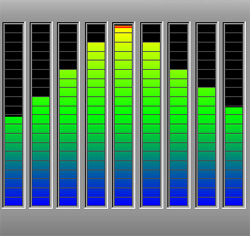The topic for this post came out of a very real conversation I had with my new audio volunteers. We got to talking about various signal levels that we deal with in the world of audio, and it became very clear that they had not yet been exposed to any of this nomenclature. I figured it’s entirely possible that some out there are also unclear on what all these terms may mean as well.
So this will be an introductory course on basic signal level. To keep it simple, I’m not going to go into all the background math that gets us here, or define every term; I’m going to stick with the practical implications of signal level. With those two caveats, simple and practical, let’s begin.
Level And Resistance
Two terms that need defining are level and resistance. For the purposes of this discussion, level refers to voltage. Voltage is analogous to water pressure. More pressure, more flow. Voltage is a measurement of the amount of force behind the signal traveling down the wires.
The voltage we’re dealing with is pretty small, so to make it easier for us sound guys to deal with, we don’t talk about it in terms of volts at all. Rather, we use the decibel, or dB. A dB is a unitless scale used to compare like values; in this case voltage.
We have a reference value, in this case 1 Volt = 0 dBV (the V signifies voltage), and we reference everything else to that voltage. Thus, -60 dBV corresponds to 1 millivolt. Someday I’ll go into the math on how we get there, for now, take my word for it. And I encourage you to do some research on your own to learn more about voltage.
The other term we need to know is resistance, which is measured in ohms. Resistance (often expressed as impedance in our world—and yes I know that impedance is actually DC resistance plus capacitance; I’m trying to keep this simple) is exactly what it sounds like, the resistance, or impediment to signal flow.
Going back to our water analogy, think of impedance as the size of the pipe you’re pushing water through. Obviously it’s a lot harder to push a large volume of water through a straw than it is a 4-inch-diameter pipe. In audio-land, we have two basic values of impedance, low (roughly 250-600 ohms) and high (roughly 1,000-10,000 ohms). At this time, don’t worry too much about the exact values, just get the concepts. Impedance matching is a whole ‘nother post.
Right, so we have that down? Signal level (dBV) and Impedance (low and high). With that as our backdrop, let’s consider the three most common types of signals we face in audio; mic level, line level and speaker level.
Mic Level
Think of a mic level signal as a low-level, low-impedance signal. Mic level is nominally around -60 dBV, so we’re looking at 1 mV (mV=millivolt, or 1/1000 of a volt, or .001 V), give or take. The impedance is also low, in the area of 250-600 ohms.
Now, even though the voltage is low, we can send mic level signals a reasonably long distance because the impedance is fairly low. When sent over a good balanced cable, mic levels will travel hundreds of feet and arrive pretty much intact.





















